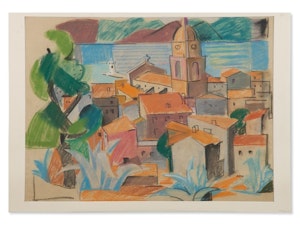Helen Flora Victoria Scales (Flora Scales)
Born Lower Hutt 1888. Studied under W. F. Calderon in London 1908-12. Returned to New Zealand. Travelled and studied in Europe 1928-31. Lived in Nelson in 1930s. Returned to England and lived in London in 1960s. Back in New Zealand about 1975.
66 Mediterranean Village. 1938. Oil, 32.7 x 40.9cm, 12 7/8 x 16 1/8 inches. Signed and dated in brush point, lower right, Flora Scales 1938. Collection: Dowse Art Gallery, Lower Hutt; donated by Mrs M. Hamersley.





